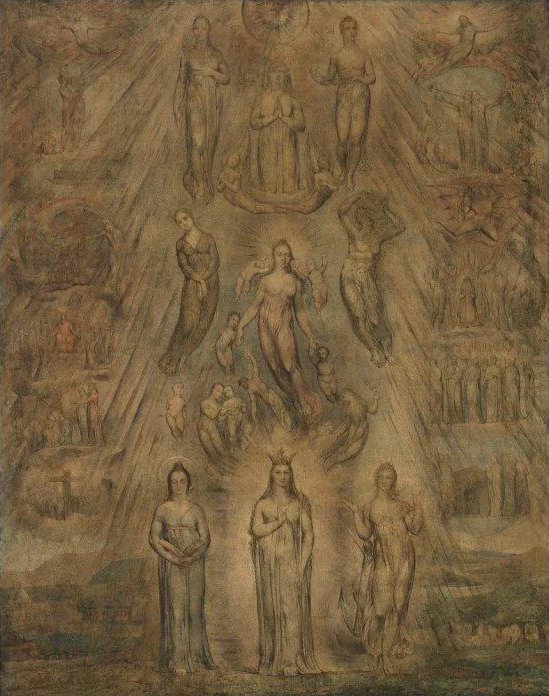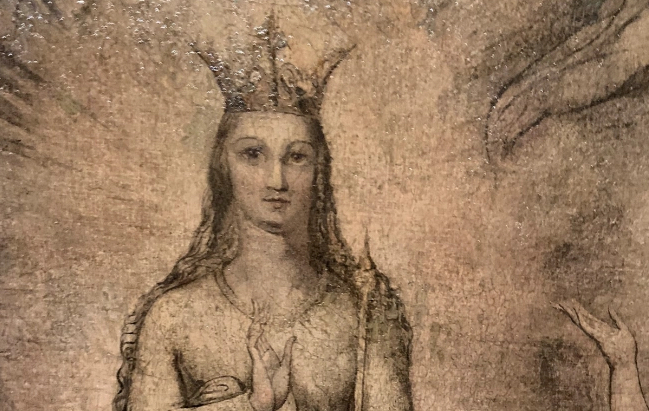William blake & Jakob Boehme – two visionaries
Throughout the thread of time there have been luminaries in every culture who have provided insights and ideas which both build upon past philosophy and taken those notions forward. The media they used to accomplish this has been varied. Some used philosophical argument, others art, yet others a religious framework to express their visions, whether they be based on practical or often mystical inputs.
Some are recognized and hailed in their own lifetimes as great and unique thinkers, while others have been ignored, ridiculed or even persecuted in their own time; and it has taken the ‘wisdom of future generations to (re)discover and bring to light’ these treasures, to paraphrase a familiar piece of ritual. One can only admire the singlemindedness of those who fell into the latter category. These were people often shunned by their peers, their friends, and lived in poverty: and yet rather than be unfaithful to their vision and their conviction of its importance were prepared to endure all of this to get their message across.
Such was William Blake, a man who, while he was raised in relative comfort and allowed to pursue his own studies by tolerant parents, never received the recognition he deserved during his own lifetime and for much of his existence was forced to live on the charity of benefactors and sponsors. By all account he was not an easy man to get on with – a trait he shared with many who follow the visionary path, and Paracelsus springs to mind – but his saving grace was a wife who understood, supported and loved him and who, more importantly, he was able to share his ideas and ambitions, who illustrated his poems, who published his books, and who even shared in his attitudes towards sexuality, considered eccentric in his age. There is the famous anecdote of his friends Thomas Butts who discovered the couple sitting naked in their summer house, reciting passages from Paradise Lost to one another! She did, however, draw the line and permitting a concubine to move in with them, despite her inability to have a child and his longing for offspring. His often radical views led his contemporaries to see in him a dreamer, perhaps someone a little ‘soft in the head’, and his proto-socialist views even a little dangerous, and he was once falsely accused of sedition against the king, a claim quickly dismissed by the courts.
To better understand Blake it is necessary to understand his sources of inspiration. We have some indication of whom he was not inspired by in his own words: “I turn my eyes to the Schools & Universities of Europe, And there behold the Loom of Locke whose Woof rages dire Wash’d by the Water-wheels of Newton.” (Jerusalem). And again, written in the margin of his copy of Discourses by Joshua Reynolds: “To Generalize is to be an Idiot; To Particularize is the Alone Distinction of Merit.” By all accounts, and as we alluded to before, visionaries are not always easy people to like or get along with, for they tend to treat anyone who disagrees with them as blind, deluded or an idiot.
Much has been written about the influences of Paracelsus ad especially Swedenborg on his work. However, one of Swedenborg’s sources who also had a profound effect on Blake was Jacob Boehme, the sixteenth century German/Bohemian mystic who was a shoemaker by trade, and who taught himself through reading the works of Paracelsus, Weigel, Schwenckfeld and others. He, like Blake, believed himself to have had a number of mystical experiences and vision which inspired him to write books and treatises despite the express hostility of Gregorius Richter, chief pastor of Goerlitz, who said of his first book, Aurora: “There are as many blasphemies in this shoemaker’s book as there are lines; it smells of shoemaker’s pitch and filthy blacking. May this insufferable stench be far from us.” His premise that man was originally in an exalted position but had fallen from grace into a state of sin and suffering through his own prevarication, but that through recognizing the path of return could reunite with the prime source also attracted the strong interest of Louis-Claude de Saint-Martin, who translated his works into French.
It is evident why Blake would not only have identified with many of the ideas of Boehme, but also with the life of the man himself, living humbly, believing himself to possess great insights which is absolutely must share with his fellow man, even under the threat of persecution. This identification of Boehme as a source for Blake’s inspiration has not entirely passed unnoticed before. Blake himself wrote to his friend John Flaxman “Paracelsus & Behmen appear’d to me before the American Revolution.”
I applaud Michael Osborne for bringing us a book which delves into this formerly obscure link between two religious visionaries. It is evident that the author feels a great affinity with William Blake, and that his abiding interest in the mystical Christian currents sometimes called Martinism or Martinezism would lead him to explore the legacy of an Englishman who had been profoundly influenced by the same currents which had inspired his near-contemporaries, Louis-Claude de Saint-Martin and Abbé Pierre Fournié, who saw in Boheme’s writings a spiritual source for the teachings they had received from the mind of Martinez de Pasqually when both had served as his secretary for a time.

Allegory of the Spiritual Condition of Man [
© Fitzwilliam Museum, Cambridge]
As a vehicle the author uses one of Blake’s tempera paintings, Allegory of the Spiritual Condition of Man, which the author claims has been largely overlooked given that it is in fact “the summa theologica of his socio-theological beliefs, and a supreme commentary on philosophical alchemy.” The author goes on to point out: “In it we discover the centrality of the metaphysics of the German mystic Jacob Boehme on Blake’s entire system.”
The image itself lends itself to both kabbalistic and alchemical interpretations, a fact not lost on the author who uses this fact to great effect both in the structure of the book, and also in linking Boheme’s theses, based on Boehme’s interest in and use of alchemical and kabbalistic imagery which so enchanted the Rosicrucians of the following generation, and later the Martinsts and Martinezists, and we have seen.
The book itself it divided into three parts. Firstly, Osborne looks at the two main protagonists, Blake and Boehme. In the second section he considers Boehme’s Three Principles of the Divine and follows these principles through both Bohme’s works and then into Blake’s. Finally, in the third section, he branches into the alchemical principles posited by Boehme and using the vehicle of the seven planets and twelve zodiacal signs, uses the Allegory to establish their presence in Blake’s thinking. Perhaps this book will do for Blake’s Allegory of the Spiritual Condition of Man hanging in the Fitzwilliam Museum in Cambridge what access to Holman Hunt’s The Light of the World has done for Keble College, Oxford, and encourage a new generation of people to travel and marvel at this enigmatic picture for which at least one person, the current author, has a possible explanation!
(The above is taken from my Preface to this book, which is now available on Amazon).



No Comments